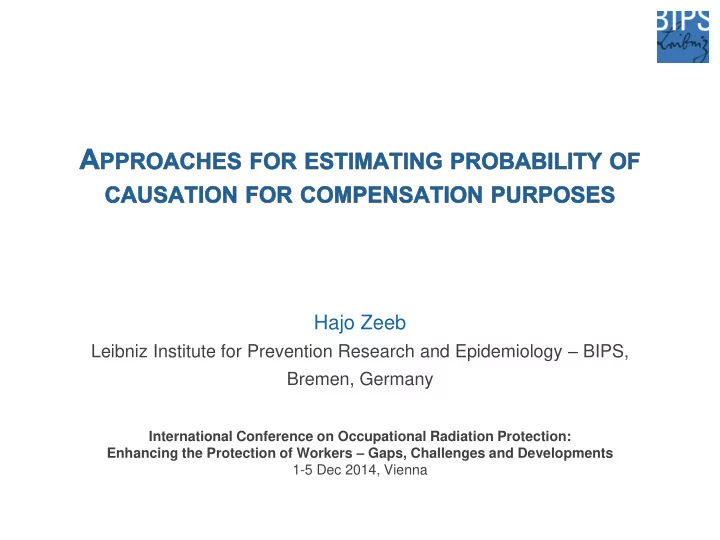

Hajo Zeeb Leibniz Institute for Prevention Research and Epidemiology – BIPS, Bremen, Germany International Conference on Occupational Radiation Protection: Enhancing the Protection of Workers – Gaps, Challenges and Developments 1-5 Dec 2014, Vienna
Overview 2 • Background – tasks from earlier conferences • Probability of causation • Basic approaches • Complexities and uncertainties • Software • Outlook • Application in different compensation frameworks
Background 3 • Occupational exposure to ionizing radiation may result in cancer among workers • Exposure-disease relation not directly observable or deducible • Countries use different approaches to decide on compensation of workers in case of alleged occupational causation • 2002 International Conference on Occupational Radiation Protection: guidance needed ! • Working group produced document co-sponsored by ILO, IAEA and WHO (2010)
Probability of Causation 5 Introduction • A diagnosed disease (say: cancer) cannot unequivocally be attributed to a – specific – cause • Did occupational ionizing radiation cause this cancer ? • How likely is it that ionizing radiation contributed to the development of this cancer ? • Approaches needed to assess the causal situation • Inference from population data to the individual case • Epidemiology (science): attribution / etiology • Includes different epidemiologic measures • Jurisdiction: probability of causation • Can be estimated by etiologic fraction (also called: assigned share)
not ‘excess’ cases 6 cases no IR exposure C 0 C 1 C 2 cases C 0 C 1 C 2 with IR exposure t 0 t 1 excess etiologic fraction = C 1 + C 2 cases Based on Ettinger/Painter 1999
Basic approaches 7 • no scientific assessment of causation of individual case possible • Way out: use of population data • Answering the question: what happens among a larger group of people with same exposure (and co-factor) conditions as known for the individual case ? • Use an (ideally) unbiased risk estimate from a comparison of exposed versus unexposed persons • Note: this is generally pertaining to excess fraction, not etiologic fraction (see previous slides)
Principle 8 Assigned share based on epidemiological estimate of relative risk (or absolute risk) 𝑆𝑆−1 • AS = 𝑆𝑆 𝐹𝐵𝑆 • AS = 𝐶 𝑑𝑏𝑜𝑑 + 𝐹𝐵𝑆 (B = baseline risk for specific cancer, EAR = Excess absolute risk) for ERR (e.g. using ERR/unit dose from LSS): 𝐹𝑆𝑆 • AS = 1+ 𝐹𝑆𝑆
Example 9 • Male leukemia case diagnosed at age 68, single exposure of 100 mSv to bone marrow at age 43 • Application of risk model (BEIR, UNSCEAR…) to the specific situation: • ERR = 0.288 0.288 • AS = 1+0.288 = 22.4% • (Missing: uncertainty, e.g. confidence bounds)
Complexities and uncertainties 10 “Simple“ estimation straight forward, blending out sources of uncertainty, e.g. Relating to the case: • Uncertain dosimetry, disease information, • information on other factors relevant to risk • …. Relating to the models used: • Shape of dose-response curve • Use of DDREF, biological effectiveness • Transport from one population to another • ….
Interactive software – Example IREP 11 https://www.niosh-irep.com/irep_niosh/
12
13
Application in Compensation programmes 14 • US Energy Employees' Occupational Illness Compensation Program Act of 2000: • 99 th precentile ≥ 50% PC: claimant eligible for compensation • UK CSRLD: sliding scale depending on PC value • Other countries: list-based approach, no PC calculation • In courts: often the 50 % PC (“more likely than not”) used, but differs between countries
Summary 15 • Causes of individual cancers unknown • Estimation of share of cancers caused by specific exposures is possible for populations • From epidemiology: concept of attributability, closely linked to causal models • Available software incorporates ways to consider uncertainty in input parameters for PC estimation • Different uses in compensation schemes and legal systems
Thank you www.bips.uni-bremen.de Contact Prof. Hajo Zeeb Leibniz Institute for Prevention Research and Epidemiology – BIPS Achterstraße 30 D-28359 Bremen zeeb@bips.uni-bremen.de
Recommend
More recommend